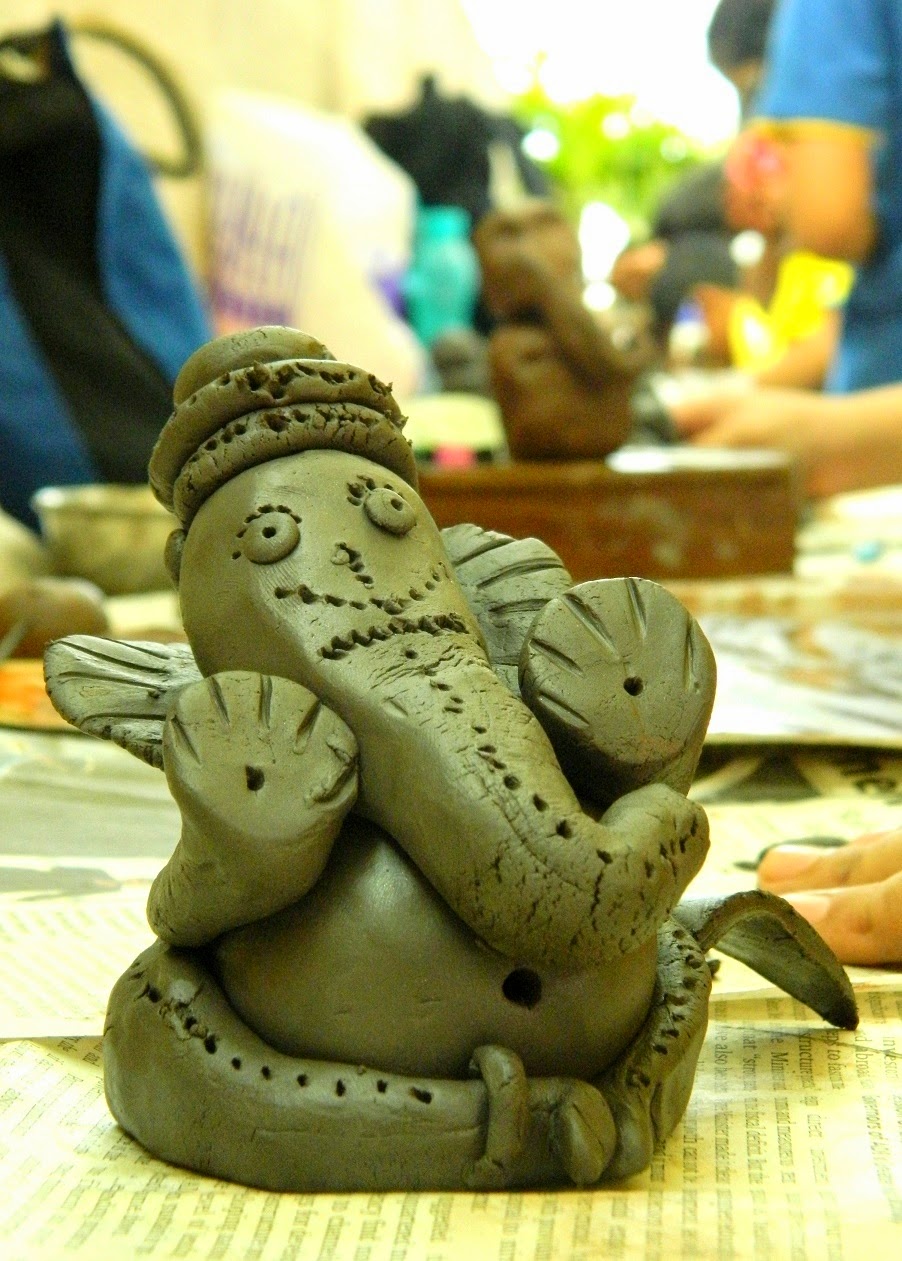Ecological roots are found in clay idols . Eco Friendly festivals.
Here’s a step by step means of making your own Ganesha idol this year.
Making idols of Clay is an ancient craft and is basically a tradition which can be revived in cities
too,to help find our ecological roots.Clay art has transformed but believe me till this day artists
make idols for Goddess Saraswati, Goddess Durga and Lord Ganesha,for the annual festivals out
of river mud or clay as a major source of employment. Making clay idols is nothing new.
We simply have to revive it.Potters made a livelihood out of this creative arts. In the ancient times
of course our first farmers were connected to earth through agriculture and then the potters were
also closely connected to earth by clay crafts. Local clay and earthen crafts are till today
an integral part in the Indian rural scenario, despite the rapid social and technological changes that are taking place.
Making idols of Clay is an ancient craft and is basically a tradition which can be revived in cities
too,to help find our ecological roots.Clay art has transformed but believe me till this day artists
make idols for Goddess Saraswati, Goddess Durga and Lord Ganesha,for the annual festivals out
of river mud or clay as a major source of employment. Making clay idols is nothing new.
We simply have to revive it.Potters made a livelihood out of this creative arts. In the ancient times
of course our first farmers were connected to earth through agriculture and then the potters were
also closely connected to earth by clay crafts. Local clay and earthen crafts are till today
an integral part in the Indian rural scenario, despite the rapid social and technological changes that are taking place.
The most common example around you is the terracotta idols you see in art shops or in villages.
Terracotta objects are mostly built by molding the clay with hand or with the wheel. Terracotta is extensively
used for making deity images in temples and other monuments.Clay artists made utensils for cooking, made bricks
and even curios.
There fore year after year we the Young Environmentalists NGO here in Mumbai keep teaching the youth
and community how to make their own Ganesha idols.One can’t merely tell people to be Eco-friendly, but when you show them how, you bring out the artist in them.Not only do they understand the concept of an
eco friendly idol, they pledge never to buy a POP idol.They in turn spread the ecological message during the
festival,simply by doing and watching.
Step one- take any good garden clay right from your own back yard which is free, potters clay for
a minimal amount or silt from the river bed. For the last ten years we have been using clay from the
River Mithi and Powai lake silt to create awareness about the water bodies.Clean it and sieve it and
cure it till it becomes earth which feels like clean soft putty in your hands.
Use the right amount of water,not too much and not too little.
Use the right amount of water,not too much and not too little.
You will know when it’s right enough when it feels like kindergarten clay.
The fact that;you are playing with clay is healing and connecting you to Mother Earth ,even without
you realizing it.
Make two parts.One portion gola or round earth bigger in size you can keep for the body or torso
of the Lord Ganesha.Remember to give the idol a sweet little
'paunch' or stomach by which Lord Ganesha
'paunch' or stomach by which Lord Ganesha
is so fondly known for. Mold it in your hands and let it sit on the ground flat.You can create a clay platform
for the idol way in advance or have a wooden tiny stage to place your idol on.
Now make another gola or ball using the smaller portion.This is what you will make the head with.
Give good finishing touches to them.
Now place the smaller portion on top of the bigger portion and smoothen out the attachment by
pinching and pressing both parts to make the body look even.Use little water to smoothen.
Keep a picture of Lord Ganesha near you while sculpting so you can get an idea of
what you would like your idol to look like.Be free,let your energy flow and simply give
in to creating your own very design.There is no hard and fast rule.
Now get a third portion and roll out a long trunk, twisting it to the right.Attach the trunk to
the body smoothly again.
Use two cylindrical long portions of clay to make the hands and keep another two elongated portions
to create the legs.Attach them to the torso like in the picture in front of you.
Be as unique and creative as you want.The more you work on the idol the more you will
see a beautiful Ganesha murti emerging right before your very eyes.
Make two large button size clay ears.Make them large and fanciful or elongated to look artistic
like in the picture.
Once you finish the hands, legs and trunk, shape and texture the sculpture into its final shape
by using toothpicks or a carving blunt knife. Use your remaining clay to add details like ‘modaks’ in
one hand of the idol, a ‘mukut’ crown for the Lord and even create the ‘mouse’ or vehicle of Lord
Ganesha.Ganesha's divine vehicle as it is said, the mouse or mooshikam represents wisdom.
You may leave it artistically raw in colour or shape or colour it with eco friendly colours and flowers.
 |
| Clay and mud helps you connect with Mother Earth. |
 |
| Teaching the blind and disabled to experience clay therapy. |
 |
| Eco Ganesha clay idol making workshop campaigns over the last ten years..by Young Environmentalists NGO. |








































